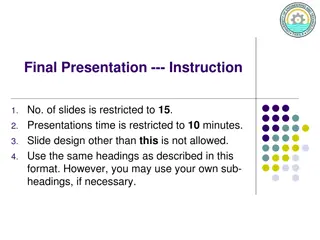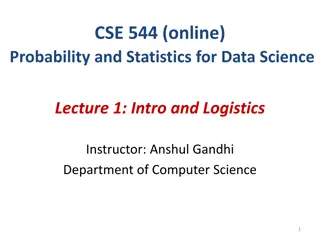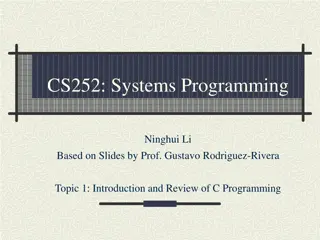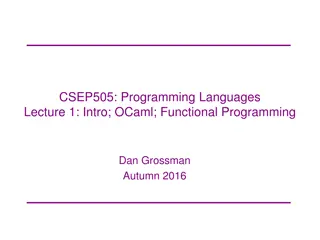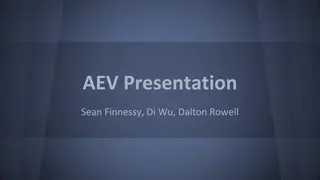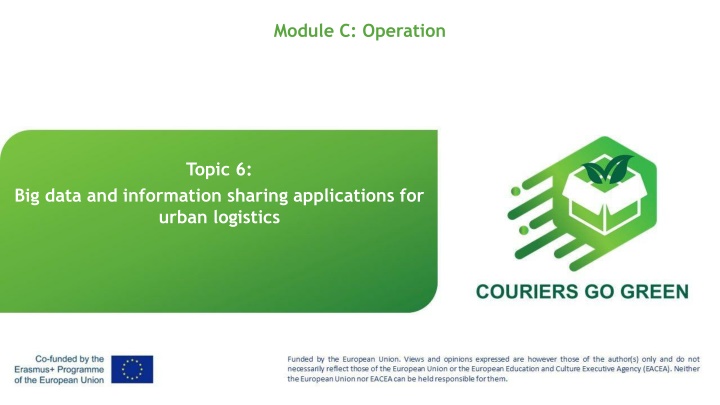
Future Trends in Urban Logistics with Big Data Impact
Explore the impact of big data on urban logistics and transportation, focusing on connectivity, smart city infrastructure, location-based services, and predictive analytics. Discover how big data is shaping the future of transportation in megacities and transforming the way travelers stay connected through smartphones, Wi-Fi, mobile data, and eSIM technology.
Download Presentation

Please find below an Image/Link to download the presentation.
The content on the website is provided AS IS for your information and personal use only. It may not be sold, licensed, or shared on other websites without obtaining consent from the author. If you encounter any issues during the download, it is possible that the publisher has removed the file from their server.
You are allowed to download the files provided on this website for personal or commercial use, subject to the condition that they are used lawfully. All files are the property of their respective owners.
The content on the website is provided AS IS for your information and personal use only. It may not be sold, licensed, or shared on other websites without obtaining consent from the author.
E N D
Presentation Transcript
Module C: Operation Topic 6: Big data and information sharing applications for urban logistics 1
Contents 1. The impact of big data in changing the future of transportation 2. Smart city infrastructure & Intelligent transportation systems 3. Location-based services 4. GIS/GPS data 5. Predictive data analytics frameworks 6. Machine learning and deep learning algorithms (AI) C. Operation 6 Big data and information sharing applications for urban logistics 2
The impact of big data in changing the future of transportation 37 megacities today dense metro areas with a population of 10+ million. By 2030, it is projected to increase to 47 The solution of transportation management World cities mobility players: Personal vehicles Public transport fleets Commercial fleets and last-mile delivery providers Micro-mobility actors (e-scooters, shared bikes, etc.) Mobility as a service providers C. Operation 6 Big data and information sharing applications for urban logistics
1. The impact of big data in changing the future of transportation Connectivity of the average traveler to internet and data Ubiquity of real-time big data in transportation How big data change the future of transportation C. Operation 6 Big data and information sharing applications for urban logistics
1.1 Connectivity of the average traveler to internet and data (1/3) Smartphone Prevalence: Most travelers now carry smartphones, which serve as their primary device for internet access. As of 2023, global smartphone penetration is over 85%, making it the most common way for travelers to stay connected. Wi-Fi Availability: Free Wi-Fi is widely available in airports, hotels, cafes, and other public spaces in most tourist destinations. However, the quality and security of these networks can vary greatly. Mobile Data: Many travelers use international roaming or purchase local SIM cards to access mobile data. The advent of affordable international data plans from major carriers has made this easier. eSIM Technology: Embedded SIM (eSIM) technology is becoming more common, allowing travelers to switch between carriers digitally without needing to swap physical SIM cards. 4G and 5G Coverage: 4G networks are widespread globally, providing fast data speeds in most urban areas. 5G is rapidly expanding, offering even faster speeds in many major cities. C. Operation 6 Big data and information sharing applications for urban logistics
1.1 Connectivity of the average traveler to internet and data (2/3) Travel Apps: Travelers heavily rely on apps for navigation (Google Maps, Waze), translation (Google Translate), booking (Airbnb, Uber), and local recommendations (TripAdvisor, Yelp). Social Media and Communication: Apps like WhatsApp, Facebook Messenger, and Skype are crucial for travelers to stay in touch with family and friends. Work Connectivity: With remote work trends, many travelers need reliable internet for video calls, cloud access, and collaboration tools. Data Security: Many travelers use VPNs (Virtual Private Networks) to secure their data when using public Wi-Fi networks. Digital Nomads: A growing subset of travelers work entirely online, making high-speed, reliable internet a critical factor in choosing destinations. C. Operation 6 Big data and information sharing applications for urban logistics
1.1 Connectivity of the average traveler to internet and data (3/3) However, connectivity can still be a challenge in some areas: Rural or remote destinations may have limited or slow internet access. Some countries have internet censorship or blocks on certain services. High roaming charges can still be an issue in some regions. Internet outages or slow speeds during peak tourist seasons. C. Operation 6 Big data and information sharing applications for urban logistics
1.2 Ubiquity of real-time big data in transportation (1/6) The ubiquity of real-time big data in transportation is a transformative trend that's reshaping how we move around. This phenomenon refers to the widespread availability and use of large-scale, instantaneous data in various transportation systems. Here's a breakdown: Data Sources: GPS from smartphones and in-vehicle systems Traffic cameras and sensors Smart traffic lights Public transit vehicle trackers Ride-hailing and bike-sharing apps Social media and crowdsourced data (e.g., Waze) IoT devices in vehicles and infrastructure Real-Time Traffic Management: Dynamic traffic light timing adjustments Variable speed limits on highways Real-time route optimization in navigation apps Immediate accident or construction alerts C. Operation 6 Big data and information sharing applications for urban logistics
1.2 Ubiquity of real-time big data in transportation (2/6) Public Transit: Live bus and train tracking Real-time arrival predictions Dynamic scheduling adjustments Occupancy data for social distancing Ride-Hailing Services: Real-time driver-passenger matching Dynamic pricing based on demand Live ETAs and route tracking Logistics and Delivery: Real-time fleet tracking Dynamic route optimization for trucks Instant package location updates Last-mile delivery coordination C. Operation 6 Big data and information sharing applications for urban logistics
1.2 Ubiquity of real-time big data in transportation (3/6) Smart City Integration: Coordinated traffic and transit management Real-time parking availability data Incident response coordination (police, ambulance) Predictive Analytics: Forecasting traffic patterns Anticipating transit demand Predicting maintenance needs Autonomous Vehicles: Real-time sensor data (LIDAR, cameras) V2V (vehicle-to-vehicle) communication V2I (vehicle-to-infrastructure) data exchange User Experience: Real-time journey planning apps Live updates on delays or disruptions Personalized travel recommendations C. Operation 6 Big data and information sharing applications for urban logistics
1.2 Ubiquity of real-time big data in transportation (4/6) Environmental Impact: Real-time emissions monitoring Dynamic tolling for congestion reduction Eco-routing in navigation apps Data Processing: Edge computing for faster response Cloud platforms for data aggregation Machine learning for pattern recognition Privacy and Security: Anonymization of user data Blockchain for secure data sharing User consent management C. Operation 6 Big data and information sharing applications for urban logistics
1.2 Ubiquity of real-time big data in transportation (5/6) The ubiquity of real-time big data in transportation leads to: More efficient use of infrastructure Reduced congestion and delays Better user experiences Lower emissions Data-driven city planning This trend is making transportation systems smarter, more responsive, and user-centric, fundamentally changing how we navigate our cities and beyond. However, challenges include: Data privacy concerns Digital divide issues System integration complexities Need for robust cybersecurity C. Operation 6 Big data and information sharing applications for urban logistics
1.2 Ubiquity of real-time big data in transportation (6/6) C. Operation 6 Big data and information sharing applications for urban logistics
1.3 Big data change the future of transportation (1/6) Big data is set to radically transform the future of transportation, reshaping how we move and revolutionizing the entire industry. Here's how: Predictive Maintenance: Using sensor data to predict vehicle issues before they occur Reducing downtime in public transit and freight Extending vehicle life and safety Autonomous Vehicles: Big data enables self-driving cars, trucks, and buses Machine learning models trained on vast driving datasets Real-time decision making from sensor data Smart Traffic Management: AI-driven traffic light systems Predictive congestion management Real-time route adjustments citywide C. Operation 6 Big data and information sharing applications for urban logistics
1.3 Big data change the future of transportation (2/6) Personalized Mobility: Data-driven, individualized travel suggestions Predicting a user's next destination Customized multimodal routing (walk, bike, bus, train) Demand-Responsive Transit: Using data to predict transit needs Dynamic bus routes and schedules On-demand shuttles in low-density areas Electric Vehicle Infrastructure: Data-optimized placement of charging stations Predictive charging to balance grid load Battery health monitoring Urban Planning: Using movement data to design better cities Optimizing road layouts and public spaces Data-driven land use decisions C. Operation 6 Big data and information sharing applications for urban logistics
1.3 Big data change the future of transportation (3/6) Shared Mobility Services: Advanced bike and scooter-sharing systems AI-driven car-sharing and carpooling Data-optimized pickup and dropoff points Freight and Logistics: Real-time supply chain visibility Predictive routing for trucks Blockchain for secure, trackable shipments Safety Enhancements: Predicting accident-prone areas Real-time hazard alerts to drivers Improving emergency response Environmental Impact: Big data for eco-routing Optimizing city systems for lower emissions Data-driven policies (e.g., congestion pricing) C. Operation 6 Big data and information sharing applications for urban logistics
1.3 Big data change the future of transportation (4/6) Public Transit Optimization: Data-driven bus and train scheduling Real-time capacity adjustments Predictive maintenance for rails and stations Transportation Equity: Data to identify underserved areas Optimizing services for accessibility Multilingual, inclusive transit apps User Behavior Insights: Understanding why people choose modes Nudging towards sustainable options Personalizing incentives Infrastructure Health: IoT sensors on bridges, roads, tunnels Predictive maintenance to prevent failures Data-driven construction planning C. Operation 6 Big data and information sharing applications for urban logistics
1.3 Big data change the future of transportation (5/6) Cross-Modal Integration: Seamless data sharing between providers One-tap booking across multiple modes Real-time intermodal connections Pricing and Revenue: Dynamic pricing in transit and tolls Personalized fare products Data-driven subsidy allocation The future of transportation, driven by big data, will be: More efficient Highly personalized Safer More sustainable Better integrated More equitable Predictive rather than reactive C. Operation 6 Big data and information sharing applications for urban logistics
1.3 Big data change the future of transportation (6/6) C. Operation 6 Big data and information sharing applications for urban logistics
2. Smart city infrastructure & Intelligent transportation systems Implementing an Intelligent Transportation System: A Bottom-Up Approach to Value Creation Connect, collect, analyze, deliver optimize traffic management with intelligent transportation systems What is an intelligent transportation system: Think of an intelligent transportation system (ITS) as an umbrella term for the cohort of emerging technology systems and solutions for enabling coordinated, efficient, and smart transportation management across different modalities car, rail, sea, and public transport. C. Operation 6 Big data and information sharing applications for urban logistics
2. Smart city infrastructure & Intelligent transportation systems An ITS is modular and can feature any number of the following: Traffic signal controls Traffic management systems Freeway management systems Transit management systems Road incident management systems Traveler information services Emergency management services Advanced traffic analytics Electronic fare payment systems Public transport management systems Connected car infrastructure Road network performance monitoring Railroad grade crossing safety systems Commercial vehicle operations systems C. Operation 6 Big data and information sharing applications for urban logistics
2. Smart city infrastructure & Intelligent transportation systems What makes transportation systems intelligent? Unlike earlier predecessors, an intelligent transport system comes with: Greater connectivity through 4G/5G, telematics, and V2X standards Better sensing capabilities courtesy of IoT devices and advanced controllers Robust analytics, leveraging the above data and augmented by predictive algorithms This combination of technologies enables traffic managers to include, engage, and supervise road users through a variety of channels such as connected car systems, personal mobile devices, and smart road infrastructure. This, in turn, helps rationalize the use and performance of existing transport systems and optimize the construction of new infrastructure. C. Operation 6 Big data and information sharing applications for urban logistics
2. Smart city infrastructure & Intelligent transportation systems Benefits of intelligent transport systems Global management of traffic flows across all types of multi-modal journeys. With great visibility and granular controls, logistics operators can precisely manage traffic and prevent congestion through intelligent planning, scheduling, and real-time controls. Reduction in road accidents. Road traffic accidents take thousands of human lives a year globally. Injuries from road events cost an estimated 2% of gross domestic product in EU countries. Traffic management and intelligent transportation systems can reduce the death toll through implementing targeted controls against speeding and distracted driving. Progressive decrease of emissions. The majority of countries have pledged net-zero emissions targets. Transportation accounts for one-fifth of global CO2 emissions, and passenger travel accounts for 60% of total transportation emissions. Better traffic management can reduce congestion in urban areas and thereby reduce pollution. Additionally, the introduction of smarter public transport options can prompt more road users to opt for alternative transportation means, including those powered by renewables. Better capacity management. An intelligent transport system can provide managers with a consolidated view of traffic flows so they can develop more effective routes, drive the use of public transport services through multi-modal traveler information systems (TISs), and add innovative mobility services to the smart transportation repertoire. Unlock new pockets of value creation. Private mobility as a service (MaaS) providers, offering carsharing and bike rental services, among others, are drawing away profits from city authorities. At the same time, they are constraining effective traffic management due to a lack of data sharing. Integrating these parties into your ITS will not only improve visibility (and thus oversight) of their operations but can also prompt new strategic partnership opportunities. C. Operation 6 Big data and information sharing applications for urban logistics
2. Smart city infrastructure & Intelligent transportation systems How to approach the implementation of an intelligent transportation system from the bottom up C. Operation 6 Big data and information sharing applications for urban logistics
2.1 Traffic management optimization with intelligent transportation systems (1/5) Intelligent Transportation Systems (ITS) leverage advanced technologies and big data to optimize traffic management, making urban mobility more efficient, safer, and sustainable. Here's how: Adaptive Traffic Signal Control: Real-time adjustment of signal timing Uses data from cameras and in-road sensors Responds to actual traffic volumes, not fixed schedules Can reduce wait times by up to 40% Dynamic Speed Limits: Variable speed signs on highways Adjusted based on weather, congestion, or incidents Smooths traffic flow, reducing stop-and-go Improves safety in adverse conditions Real-Time Traffic Prediction: Machine learning models forecast congestion Uses historical data, events, weather Allows proactive traffic management Informs drivers via navigation apps C. Operation 6 Big data and information sharing applications for urban logistics
2.1 Traffic management optimization with intelligent transportation systems (2/5) Smart Ramp Metering: AI-controlled highway on-ramp signals Manages the rate of vehicles entering Prevents highway flow breakdown Can increase throughput by 20-30% Connected Vehicle Technology (V2X): Cars communicate with each other (V2V) Also with infrastructure (V2I) Shares data on speed, braking, hazards Enables cooperative traffic optimization Incident Detection & Response: AI analyses camera feeds and sensor data Instantly detects accidents or debris Alerts responders and diverts traffic Significantly reduces clearance time Smart Parking Systems: Real-time parking availability data Guides drivers to open spots Reduces time spent searching Cuts congestion from "parking cruising" C. Operation 6 Big data and information sharing applications for urban logistics
2.1 Traffic management optimization with intelligent transportation systems (3/5) Transit Signal Priority: Buses or trams request green lights Based on schedule adherence and occupancy Improves public transit reliability Encourages shift from private cars Dynamic Lane Management: Adjustable lane directions Used for morning/evening rush hours Or for special events Maximizes road capacity Predictive Maintenance: IoT sensors on roads and bridges Detect issues before they cause delays Schedules repairs at low-traffic times Prevents surprise lane closures Environmental Traffic Management: Monitors air quality in real time Adjusts traffic to reduce emissions May restrict high-polluting vehicles Routes based on air quality zones C. Operation 6 Big data and information sharing applications for urban logistics
2.1 Traffic management optimization with intelligent transportation systems (4/5) Event and Construction Management: Data-driven planning for big events Real-time updates to navigation apps Dynamic signage around work zones Prevents unexpected congestion Emergency Vehicle Preemption: Ambulances, fire trucks get green lights Reduces response times Increases safety at intersections Coordinated with traffic signals Pedestrian and Cyclist Safety: Smart crosswalks detect people Extend crossing time if needed Warn drivers of pedestrians Bike-specific traffic lights Data-Driven Policy: Analytics inform long-term planning Identifies chronic bottlenecks Guides infrastructure investments Shapes policies like congestion pricing C. Operation 6 Big data and information sharing applications for urban logistics
2.1 Traffic management optimization with intelligent transportation systems (5/5) Benefits and Challenges of ITS in-Traffic Management Benefits of ITS in-traffic management: Reduced travel times (up to 25%) Lower emissions Fewer accidents Improved emergency response Better use of existing roads Enhanced quality of life Challenges of ITS in-traffic management : High initial tech costs Need for data standardization Cybersecurity concerns Requires agency coordination Public acceptance of new systems C. Operation 6 Big data and information sharing applications for urban logistics
3. Location-Based Services What is LBS LBS is of critical essence to most businesses to drive real insight from data linked to specific geolocations where the activity takes place. Certain spatial patterns are detected when using location-related data and services. This data provides one of the most valuable and powerful tools where location is the common denominator in all your business-related activities that can be leveraged to understand relationships and patterns. Services GIS & Mapping: GIS & mapping systems create, manage, and analyze location data, providing the foundation for research and mapping used in many industries. GIS can help improve decision- making, management, and efficiency in business processes that rely on geographical data. Collect & manage data See changes Locate problems Receive notifications Get forecast Understand trends C. Operation 6 Big data and information sharing applications for urban logistics
3. Location-Based Services Services - Continue Outdoor: Outdoor systems use GPS data to provide navigation, routing, and positioning capabilities for your software. Outdoor systems are commonly used in taxi, ride-sharing, and navigation applications. Positioning Tracking Navigation Marketing Social media Sport C. Operation 6 Big data and information sharing applications for urban logistics
3. Location-Based Services Services - Continue Indoor: Indoor positioning systems differ heavily from previous technologies as they utilize different tech to determine positions inside structures. The challenge of indoor systems is to develop an accurate enough to suit the appropriate needs. These systems have different applications ranging as far as security. Positioning Tracking Navigation Marketing Networking Safety C. Operation 6 Big data and information sharing applications for urban logistics
4. GIS/GPS Data What is GIS, and How Does It Differ From GPS? Often, when we speak of the necessity to build a real-time map application, the first thing that comes to mind is GPS. Since both GPS and GIS serve a similar purpose and their names look pretty much the same, it makes sense to highlight their main features. Drawing the line between these technologies will help to understand how to build the most optimal software solution for your logistics and transportation business. GPS, or Global Positioning System, is a satellite-based navigation technology that allows users to determine their precise location and track their movements in real time. All satellites have atomic clocks and transmit signals simultaneously. The GPS receiver, in its turn, can calculate the current position by estimating the distance between the user and at least four satellites which data it receives. It s a rather complicated principle of operation, we must say. However, the good news is that any transportation organization or a regular person with a GPS receiver can access this data freely. This technology has become an essential tool used in many solutions for the logistics industry. It s easy to use and helps companies to optimize their operations and improve efficiency. Here are some examples of how GPS tracking software can be used in logistics. C. Operation 6 Big data and information sharing applications for urban logistics
4. GIS/GPS Data What is GIS, and How Does It Differ From GPS? Often, when we speak of the necessity to build a real-time map application, the first thing that comes to mind is GPS. Since both GPS and GIS serve a similar purpose and their names look pretty much the same, it makes sense to highlight their main features. Drawing the line between these technologies will help to understand how to build the most optimal software solution for your logistics and transportation business. GPS, or Global Positioning System, is a satellite-based navigation technology that allows users to determine their precise location and track their movements in real time. All satellites have atomic clocks and transmit signals simultaneously. The GPS receiver, in its turn, can calculate the current position by estimating the distance between the user and at least four satellites which data it receives. It s a rather complicated principle of operation, we must say. However, the good news is that any transportation organization or a regular person with a GPS receiver can access this data freely. This technology has become an essential tool used in many solutions for the logistics industry. It s easy to use and helps companies to optimize their operations and improve efficiency. Here are some examples of how GPS tracking software can be used in logistics. C. Operation 6 Big data and information sharing applications for urban logistics
4. GIS/GPS Data Using GIS Solutions in Logistics and Transportation C. Operation 6 Big data and information sharing applications for urban logistics
5. Predictive data analytics frameworks Asset Management Evolution C. Operation 6 Big data and information sharing applications for urban logistics
5. Predictive data analytics frameworks Predictive Maintenance: Opportunities Ahead C. Operation 6 Big data and information sharing applications for urban logistics
6. Machine learning and deep learning algorithms (AI) in Transportation Basic Services created C. Operation 6 Big data and information sharing applications for urban logistics
6. Machine learning and deep learning algorithms (AI) in Transportation Reinforcement learning in autonomous vehicles C. Operation 6 Big data and information sharing applications for urban logistics
6. Machine learning and deep learning algorithms (AI) in Transportation Smart vehicle architecture C. Operation 6 Big data and information sharing applications for urban logistics
C. Operation 6 Big data and information sharing applications for urban logistics Thank you for your attention! C. Operation 6 Big data and information sharing applications for urban logistics 41












